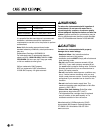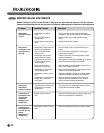
36
CLEANING THE REFRIGERATOR
wWARNING
Explosion Hazard
• Use nonflammable cleaner.
• Failure to do so can result in death,
explosion, or fire.
Both the refrigerator and freezer sections defrost
automatically. However, clean both sections about
once a month to prevent odors. Wipe up spills
immediately.
• Unplug the refrigerator.
• Remove all removable parts, such as shelves and
crispers.
• Use a clean sponge or soft cloth and a mild
detergent in warm water. Do not use abrasive or
harsh cleaners.
• Hand wash, rinse, and thoroughly dry all surfaces.
• Plug in the refrigerator.
NOTE: Window sprays, abrasive cleaners, or
flammable fluids can scratch or damage plastic
covers or panels.
Cleaning the Exterior
For models with a stainless steel exterior, use a
commercially available stainless steel cleaner in
accordance with the manufacturer’s instructions.
You may also use a clean sponge or soft cloth and
a mild detergent in warm water. Do not use abrasive
or harsh cleaners. Dry thoroughly with a soft cloth.
IMPORTANT: Do not use cleaning waxes,
concentrated detergents, or cleaners containing
petroleum on plastic refrigerator parts such as door
liners or gaskets.
Care and Cleaning of the Interior
NOTE: Allow the freezer to warm so the cleaning
cloth will not stick.
To help remove odors, you can wash the inside of
the refrigerator with a mixture of baking soda and
warm water. Mix 2 tbsp. baking soda to 1 qt. of water
(26 g soda to 1 L of water). Be sure the baking soda
dissolves completely so it does not scratch the
surfaces of the refrigerator.
IMPORTANT: Do not use a spray nozzle to clean
the interior.
GENERAL INFORMATION
Storage
During average-length vacations, you will
probably find it best to leave the refrigerator in
operation. Place freezable items in the freezer for
longer life.
When you plan to store the refrigerator, remove
all food, disconnect the power cord, clean the
interior thoroughly, and block the doors open to
prevent mold and mildew. Be certain the stored
refrigerator does not present a child entrapment
danger.
Moving
Unload the refrigerator to move it. (This is probably
not necessary when pulling it out to clean behind it.)
Be sure to let the refrigerator warm up to room
temperature, and dry the inside before closing the
doors to pack it for moving. To avoid damaging the
height-adjusting screws, turn them all the way into the
base.
Power Failure
Most power failures that are corrected within an
hour or two will not affect your refrigerator
temperatures. However, you should minimize the
number of door openings while the power is off.
Water may drip from the ice bin during a power
outage. To prevent this, remove the ice bin, discard
all of the ice, towel dry, and replace.


















